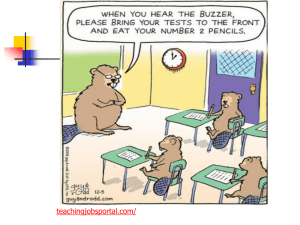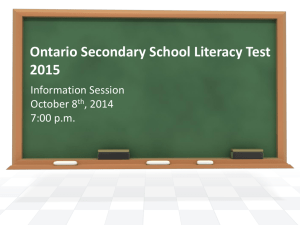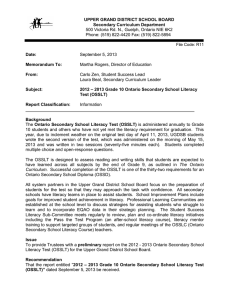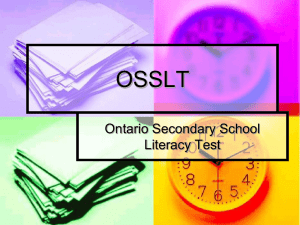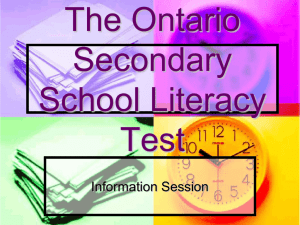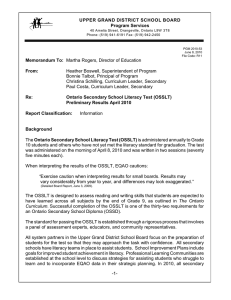UPPER GRAND DISTRICT SCHOOL BOARD Program Services 2011 06 14
advertisement
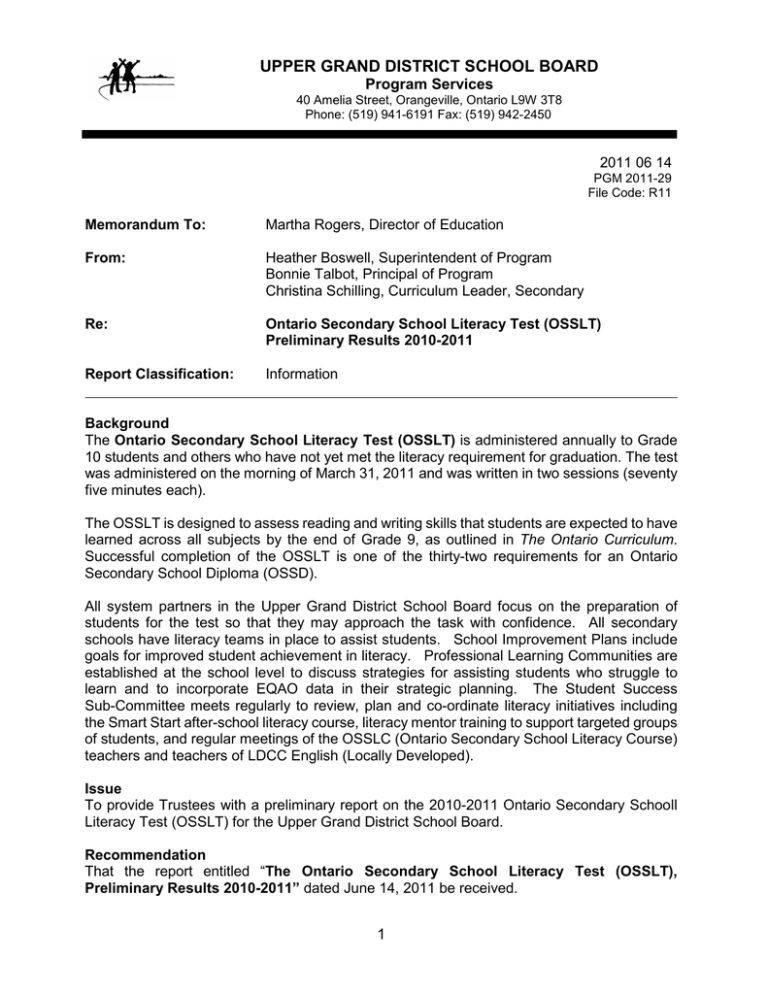
UPPER GRAND DISTRICT SCHOOL BOARD Program Services 40 Amelia Street, Orangeville, Ontario L9W 3T8 Phone: (519) 941-6191 Fax: (519) 942-2450 2011 06 14 PGM 2011-29 File Code: R11 Memorandum To: Martha Rogers, Director of Education From: Heather Boswell, Superintendent of Program Bonnie Talbot, Principal of Program Christina Schilling, Curriculum Leader, Secondary Re: Ontario Secondary School Literacy Test (OSSLT) Preliminary Results 2010-2011 Report Classification: Information Background The Ontario Secondary School Literacy Test (OSSLT) is administered annually to Grade 10 students and others who have not yet met the literacy requirement for graduation. The test was administered on the morning of March 31, 2011 and was written in two sessions (seventy five minutes each). The OSSLT is designed to assess reading and writing skills that students are expected to have learned across all subjects by the end of Grade 9, as outlined in The Ontario Curriculum. Successful completion of the OSSLT is one of the thirty-two requirements for an Ontario Secondary School Diploma (OSSD). All system partners in the Upper Grand District School Board focus on the preparation of students for the test so that they may approach the task with confidence. All secondary schools have literacy teams in place to assist students. School Improvement Plans include goals for improved student achievement in literacy. Professional Learning Communities are established at the school level to discuss strategies for assisting students who struggle to learn and to incorporate EQAO data in their strategic planning. The Student Success Sub-Committee meets regularly to review, plan and co-ordinate literacy initiatives including the Smart Start after-school literacy course, literacy mentor training to support targeted groups of students, and regular meetings of the OSSLC (Ontario Secondary School Literacy Course) teachers and teachers of LDCC English (Locally Developed). Issue To provide Trustees with a preliminary report on the 2010-2011 Ontario Secondary Schooll Literacy Test (OSSLT) for the Upper Grand District School Board. Recommendation That the report entitled “The Ontario Secondary School Literacy Test (OSSLT), Preliminary Results 2010-2011” dated June 14, 2011 be received. 1 Results EQAO determines results in two ways: All Eligible Students (M1): This method of reporting provides percentages based on all students in the cohort who are working toward an OSSD. The only students excluded are those who are not working toward an OSSD (exempt students). Fully Participating Students (M2): This method of reporting provides percentages based on students for whom there is work for both sessions of the administration of the OSSLT and who were assigned an achievement result (successful, not successful). Students who are not working toward an OSSD, those who were absent, and those who were deferred are excluded. Participation Data of all First-Time Eligible Students (M1) Province 2009-10 Total number of students working toward a diploma UGDSB UGDSB 2009-10 Province 2010-11 2010-11 153 490 2680 153 365 2703 Percentage of eligible students who fully participated 93% 94% 93% 94% Percentage of students absent 4% 3% 2% 3% Percentage of students deferred 2% 2% 5% 2% Participation Data Demographic Overview of (M1) First Time Eligible Students in the UGDSB 2009-10 2010-11 47% 53% 48% 52% 1% 1% 16% 16% Identified students With Special Needs Receiving Accommodations (excluding gifted) 13% 13% Programs of Study* 62% 30% 6% 1% 2% 62% 29% 6% 1% 3% Gender female male English Language Learners Identified students With Special Needs (excluding gifted) Academic Applied Locally Developed English as a Second Language Other (Percentages may not add up to 100, due to rounding) 2 OSSLT Results - all First-Time Eligible (M1) Province 2009-10 2009-10 Province 2010-11 2010-11 Successful 78% 81% 77% 79% Not Successful 15% 14% 16% 16% Absent 2% 3% 2% 3% Deferred 5% 2% 5% 2% UGDSB UGDSB OSSLT Results - Fully Participating, First-Time Eligible (M2) UGDSB UGDSB Province 2009-10 2009-10 Province 2010-11 2010-11 Successful 84% 85% 83% 84% Not Successful 16% 15% 17% 16% OSSLT Success Rates - Fully Participating (M2), First-Time Eligible UGDSB UGDSB Province 2009-10 2009-10 Province 2010-11 2010-11 Female 82% 88% 87% 87% Male 74% 82% 80% 80% English Language Learners 63% 71% 68% 81% Special Needs (excluding gifted) 55% 46% 52% 48% OSSLT Success Rates - Fully Participating (M2), First-Time Eligible, Level of Study UGDSB UGDSB Province 2009-10 2009-10 Province 2010-11 2010-11 Academic 95% 98% 95% 97% Applied 60% 71% 55% 65% LDCC 19% 14% 15% 11% ESL/ELD 46% n/r 51% n/r (Percentages may not add up to 100, due to rounding) 3 OSSLT Results - All Previously Eligible (M1) UGDSB Province 2009-10 UGDSB 2009-10 Province 2010-11 2010-11 Successful 28% 32% 27% 30% Not Successful 27% 26% 28% 28% Absent 12% 20% 11% 19% Deferred 13% 9% 13% 9% Opting for the OSSLC 20% 13% 22% 15% OSSLT Results - Fully Participating (M2), Previously Eligible UGDSB UGDSB Province 2009-10 2009-10 Province 2010-11 2010-11 Successful 51% 55% 49% 51% Not Successful 49% 45% 51% 49% OSSLT Success Rates - Fully Participating (M2), Previously Eligible UGDSB UGDSB Province 2009-10 2009-10 Province 2010-11 2010-11 Female 55% 62% 54% 59% Male 48% 51% 46% 45% English Language Learners 42% 45% 49% 43% Special Needs (excluding gifted) 37% 40% 34% 32% (Percentages may not add up to 100, due to rounding) 4 Summary Board results have been fairly consistent over the past five years and follow the provincial trend. Students in Academic and Applied level classes performed above the provincial average, although there is always work to do in individual schools. Early targeted intervention and support has helped some students to be more successful. This attention needs to be continually directed towards those students who are taking Applied or LDCC classes, students with special needs, and students who are writing the test for the second time. We will need to work together with our special education teachers, resource teachers and literacy leads to best support all of our students. Rationale The release of the results of the 2011 OSSLT provides important information for the system and its schools. The information offers an opportunity to conduct an analysis of the results in order to identify best instructional practices, which in turn should prompt the best possible student achievement. The collection and preliminary reporting of the data is the necessary first step in the process of critical analysis. The next step in this process will be to continue the identification of areas of focus. Groups such as the Literacy Sub-Committee of the Student Success initiative, school literacy teams, and Curriculum Leaders will use these areas to direct efforts. Planning for increased student success will then occur at both the school and system level. 5 Appendix A OSSLT Release Dates, 2011: May 30 Preliminary Student Summary (available to directors and principals) May 31 Application to submit an appeal will be available to principals June 8 Highlights of the Provincial Results Detailed School and Board results (confidential until June 15) June 14 Detailed school and board results (confidential until June 15) Public reports: school and board results (confidential until June 15) Summary of Results over Time (available to directors) Profile of strengths and areas for improvement reports June 15 Public Reports: School and Board Results June 20-24 Individual Student Reports June 22 Item Information Reports: Student Roster (available to principals) Files containing data from student roster reports (available to directors) Profile of Strengths and Areas for Improvement Report Results for students with special needs and students receiving accommodations Tracking a cohort=s achievement (available to principals and directors) Detailed results for aboriginal students 6
